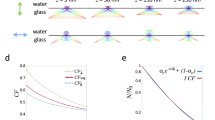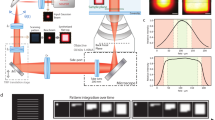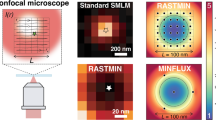Abstract
We introduce an interferometric single-molecule localization method for super-resolution fluorescence microscopy. Fluorescence molecules are located by the intensities of multiple excitation patterns of an interference fringe, providing around a twofold improvement in the localization precision compared with the conventional imaging with the same photon budget. We demonstrate this technique by resolving nanostructures down to 5 nm in size over a large 25 × 25 μm2 field of view.
This is a preview of subscription content, access via your institution
Access options
Access Nature and 54 other Nature Portfolio journals
Get Nature+, our best-value online-access subscription
$29.99 / 30 days
cancel any time
Subscribe to this journal
Receive 12 print issues and online access
$259.00 per year
only $21.58 per issue
Buy this article
- Purchase on Springer Link
- Instant access to full article PDF
Prices may be subject to local taxes which are calculated during checkout



Similar content being viewed by others
Data availability
The data that support the findings of this study are available from the corresponding author upon request.
Code availability
MATLAB programs for simulation data generation and data analysis are freely available for academic use and are provided online with this paper as Supplementary Software. The LabVIEW program for device controlling and the Python program for drift correction during imaging, which are hardware-dependent, are available from the corresponding author upon request.
Change history
22 October 2019
An amendment to this paper has been published and can be accessed via a link at the top of the paper.
References
Betzig, E. et al. Science 313, 1642–1645 (2006).
Hess, S. T., Girirajan, T. P. K. & Mason, M. D. Biophys. J. 91, 4258–4272 (2006).
Rust, M. J., Bates, M. & Zhuang, X. Nat. Methods 3, 793 (2006).
Thompson, R. E., Larson, D. R. & Webb, W. W. Biophys. J. 82, 2775–2783 (2002).
Zheng, Q. et al. Chem. Soc. Rev. 43, 1044–1056 (2014).
Vogelsang, J. et al. Angew. Chem. Int. Ed. 47, 5465–5469 (2008).
Dai, M., Jungmann, R. & Yin, P. Nat. Nanotechnol. 11, 798 (2016).
Weisenburger, S. et al. ChemPhysChem 15, 763–770 (2014).
Li, W., Stein, S. C., Gregor, I. & Enderlein, J. Opt. Express 23, 3770–3783 (2015).
Liu, B. et al. Sci. Rep. 5, 13017 (2015).
Balzarotti, F. et al.Science 355, 606–612 (2017).
Shtengel, G. et al. Proc. Natl Acad. Sci. USA 106, 3125–3130 (2009).
Aquino, D. et al. Nat. Methods 8, 353 (2011).
Huang, F. et al.Cell 166, 1028–1040 (2016).
Jungmann, R. et al. Nat. Methods 11, 313–318 (2014).
Gustafsson, M. G. L. J. Microsc. 198, 82–87 (2000).
Lew, M. D., Backlund, M. P. & Moerner, W. E. Nano Lett. 13, 3967–3972 (2013).
Acknowledgements
We thank L. Pan for helping with the preparation of COS-7 cells stained with Alexa-647-labeled phalloidin, and Y. Zhang and B. Liu for discussions. This work was supported by the National Key Research and Development Program of China (grant no. 2017YFA0505300 to W.J., grant no. 2016YFA0500200 to T.X., grant no. 2016YFA0502400 to W.J.), the National Foundation of Natural Science of China (grant no. 31730054, 31661143041, 31127901 to T.X., grant no. 31700743 to L.G.), Beijing Municipal Science & Technology Commission project no. Z181100004218002 (to T.X.), the Instrument Development Project of CAS (grant no. GJJSTD20180001 to T.X., grant no. YJKYYQ20180069 to W.J.) and the Youth Innovation Promotion Association of CAS (grant no. 2013066 to W.J. and grant no. 2017135 to L.G.).
Author information
Authors and Affiliations
Contributions
W.J., T.X. and L.G. designed the experiments. W.J. and L.G. developed the ROSE system. L.G. performed data analysis. Y.L. and S.Z. conducted sample preparation and imaging. T.X., W.J., L.G., D.L., Y.X. and W.L. interpreted the results. W.J., T.X. and L.G. wrote the manuscript, which was modified by all of the other authors.
Corresponding authors
Ethics declarations
Competing interests
The authors declare no competing interests.
Additional information
Peer review information Rita Strack was the primary editor on this article and managed its editorial process and peer review in collaboration with the rest of the editorial team.
Publisher’s note Springer Nature remains neutral with regard to jurisdictional claims in published maps and institutional affiliations.
Integrated supplementary information
Supplementary Figure 1 One pair of raw images from 2 EMCCDs.
Each image of 512*512 pixels contains 3 subimages indicated by subimage 1-6. The size of each subimage is about 170*170 pixels, with a pixel size of 150 nm, yielding a FOV of about 25*25 μm2. The yellow arrows indicate the same single molecule in six subimages. 5 experiments were repeated independently with similar results.
Supplementary Figure 2 Optical setup of ROSE.
Laser1: MSL-FN-639, CNI; Laser2: MLL-III-405, CNI; AOTF: AOTFnC-400.650, AA; Fiber Coupler: HPUC-23AF-400/700-P-4.5AC-15, OZ; Fiber Collimator: HPUCO-23-400/700-P-6AC, OZ; PM fiber: QPMJ-3AF3S-400-3/125-3AS-3-1, OZ; Half waveplate: WPH05M-633, Thorlabs; Polarizer: GT10-A, Thorlabs; EOM1: LM0202, QiOptiq; EOM2 and 3: Model 350-50, ConOptics; Beam Expander: GCO-2501, CDH; PBS: PBS251, Thorlabs; Mirror: PFSQ10-03-P01, Thorlabs; DM1: Di02-R514-25x36, Semrock; DM2: Di03-R405/488/561/635-t1-25x36, Semrock; DM3: FF520-Di02-25x36, Semrock; CCD1 and 2: iXon 897 EMCCD, Andor; CCD3: Guppy F-033B, Allied Vision Technologies; Resonant Mirror: CRS 4 KHZ, CTI; DAQ: USB-6343, NI; CPLD: epm570t100c5n, Altera.
Supplementary Figure 3 Time sequence diagram of ROSE.
This figure shows the signal for ATOF and EOMs to switch the illumination patterns, which was generated by DAQ and synchronized with the resonant scanner. This time sequence diagram was illustrated with 100 ms exposure. One exposure includes approximately 800 switch cycles, each with switch of 6 illumination patterns. The scanning cycle was 125 μs, with each illumination pattern of approximately 20 μs, with the AOTF on-time of 11.25 μs, resulting in a duty cycle of about 54% for the illumination.
Supplementary Figure 4 The relation between on-off switching times and the localization precision under various scan cycle times.
The simulated off-time subjects to exponential distribution with average values of 1 ms, 5 ms, 15 ms, 50 ms, 150 ms, 500 ms, 1,500 ms and 5,000 ms, and the simulated average on-time subjects to exponential distribution with average values from 1 ms to 100 ms, which covers most experimental conditions. The scan cycle time of 0.125 ms, 2.5 ms and 25 ms were tested, which represents the typical scan cycle time for resonant scanner, standard galvo scanner and sequential exposure to get 6 subimages without scanning configuration, respectively. For each condition, 1000 frames were generated for the statistical analysis, each point represents the mean value with error bars representing a 95% confidential interval.
Supplementary Figure 5 Localization procedure of ROSE along one of the lateral directions.
Three subimages were acquired corresponding to the three illumination patterns. Then Gaussian fitting was performed to estimate the rough position and three photon numbers. The three photon numbers were then used to estimate the phase. An alignment of the phase and the rough position will provide precise position.
Supplementary Figure 6 Demonstration of periodical linear fitting in 1D.
Each localization contains both localization information and phase information, shown as the scatter plot of blue dots. After the periodical linear fitting, the relation between localization and the phase could be identified as shown by the red points.
Supplementary Figure 7 Calibration of the fringes in x and y directions.
The position scanning was performed by a piezo stage, with steps of 20 nm. The linear regression results showed that the periodic length of fringe in the x direction (a) and y direction (b) are 222.6 nm and 215.7 nm, respectively. The excitation laser wavelength of 639 nm and the N.A. of 1.49, resulting in a theoretical minimal achievable periodic length of 214.4 nm. For the data in a to b, n = 20 images were acquired at each position for the analysis.
Supplementary Figure 8 The modulation depth and its influence on the localization precision.
(a) Simulated data shows the relation between modulation depth and localization precision with 2000 photon number. (b and c) Experimental modulation depth estimated by measurement of 40 nm fluorescent nanospheres, which showed a high contrast of the fringe with modulation depth of 0.91 in x direction (b) and 0.92 in y direction (c). (d and e) Experimental modulation depth estimated by measurement of 40 nm fluorescent nanospheres, which showed a nearly uniform high contrast of the fringe within the range of FOV. For each condition in (a), 1,000 frames were generated for the statistical analysis, and each point represents the mean value with the error bar represents for a 95% confidential interval. 550 measurements were taken in x- and y- directions in b and c, respectively. For each fluorescent spheres in d and e, 20 measurements were performed and the number indicates the mean modulation depth. Scale bar: 5 μm in d and e.
Supplementary Figure 9 The phase step error and its influence on localization precision and bias.
(a) Simulated data showed the relation between phase step error and the localization precision with an assumed pi*2/3 fixed step size and 2000 photon number. (b) Theoretical phase estimation bias with different phase step error. (c) The system phase step calibration results showed phase step error below 2 degree. 1,000 frames were generated for each condition in (a), and each point represents the mean value with the error bar represents for a 95% confidential interval. 500 measurements were taken in each condition in c.
Supplementary Figure 10 Design and measurement results of DNA origami structures.
(a) AFM image of the synthesized DNA origami. (b) Design of the DNA origami structures for DNA-PAINT imaging. (c and e) Averaged image of the 20 nm DNA origami structures reconstructed by centroid fitting (c) and ROSE (e), respectively, with the center of each cluster (red cross) compared with the designed lattice pattern (green cross). (d and f) Measured 20 nm structure lattice constants of c and e, shown as design schematics. (g) Averaged image of the 5 nm DNA origami structures reconstructed by ROSE, with the center of each cluster (red cross) compared with the designed lattice pattern (green pattern). (h) Multi 2D Gaussian fitting result of g, with the designed lattice pattern (green cross). (i) Measured 5 nm structure lattice constants of g, shown as design schematics. Scale bars: 100 nm in a, 20 nm in c, e, g and h. For the data in a, 5 experiments were repeated independently with similar results. For the data in c to f, the total number of averaged structures was 92, and the center indicates the mean value. 5 experiments were repeated independently with similar results. For the data in g to i, the total number of averaged structures was 169 and the center indicates the mean value. 5 experiments were repeated independently with similar results.
Supplementary Figure 11 The 20 nm and 10 nm DNA origami structures over a large field of view.
The images were reconstructed with centroid fitting (a) and ROSE (b), respectively, each image with a gallery of zoomed 20 nm (gallery bottom) and 10 nm (gallery top) structures. Scale bar: 200 nm (large image) and 50 nm (gallery). For data in a and b, 5 experiments were repeated independently with similar results.
Supplementary Figure 12 The 5 nm DNA origami structures over a large field of view with ROSE.
With a gallery of zoomed 20 nm (gallery bottom) and 5 nm (gallery top) structures respectively. Scale bar: 200 nm (up) and 50 nm (down). 5 experiments were repeated independently with similar results.
Supplementary Figure 13 Comparison of centroid fitting and ROSE imaging of clathrin-coated pits (CCP) in COS-7 cells.
(a) Wide field of the fluorescent image. (b) Reconstructed image with ROSE, showing the hollow structures of the CCPs. (c and d) Zoomed in images of the reconstruction with conventional centroid fitting (c) and ROSE (d), respectively. (e) Distribution of the photon number of single molecules showing a mean number of 451 and median number of 391. (f) Intensity profile of the cross-section indicated in c and d. The diameter of the hollow structure was 90.3 nm, which could not be clearly resolved in (c) by the centroid fitting method. (g) Intensity profile of the cross section indicated in c and d. Scale bars: 1 μm in a and b; 500 nm in d. The width of ROI in c and d is 30 nm. For data in a to d, 5 experiments were repeated independently with similar results.
Supplementary Figure 14 Comparison of PSF width between ROSE and conventional images.
(a) 6 subimages of ROSE and conventional image of 40 nm fluorescent spheres, with zoomed in on the right indicated by the yellow rectangle. (b-e) Distribution of PSF width in standard derivation of ROSE (b and d) and conventional image (c and e) in x and y directions, respectively. Scale bars: 5 μm (left of each image pair in a) and 1 μm (right of each image pair in a). For data in a, 5 experiments were repeated independently with similar results.
Supplementary Figure 15 Phase drift and direction stability of fringes.
(a) Phase drift of two fringes within 600 seconds, showing a 0.1 rad drift of fringe X and about 0.4 rad drift of fringe Y, respectively. (b and c) Direction stability of fringe X (b) and fringe Y (c), the direction was calculated as the angle to the x-axis, so the angle of fringe X is near 0 and the angle of fringe Y is near pi/2.
Supplementary information
Supplementary Information
Supplementary Figs. 1–15 and Notes 1–4.
Rights and permissions
About this article
Cite this article
Gu, L., Li, Y., Zhang, S. et al. Molecular resolution imaging by repetitive optical selective exposure. Nat Methods 16, 1114–1118 (2019). https://doi.org/10.1038/s41592-019-0544-2
Received:
Accepted:
Published:
Issue Date:
DOI: https://doi.org/10.1038/s41592-019-0544-2
This article is cited by
-
Temporal analysis of relative distances (TARDIS) is a robust, parameter-free alternative to single-particle tracking
Nature Methods (2024)
-
Real-time single-molecule 3D tracking in E. coli based on cross-entropy minimization
Nature Communications (2023)
-
Scanning single molecule localization microscopy (scanSMLM) for super-resolution volume imaging
Communications Biology (2023)
-
HOPE-SIM, a cryo-structured illumination fluorescence microscopy system for accurately targeted cryo-electron tomography
Communications Biology (2023)
-
Tetra-color superresolution microscopy based on excitation spectral demixing
Light: Science & Applications (2023)



